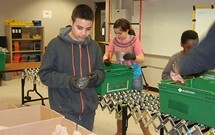
Teachers, are you having trouble convincing students in your STEM classes that the subject matter has relevance for their lives? Of course you are! What teacher isn’t? Luckily programs exist for this generation of hard-to-convince students that can help you. Among these is Rochester Institute of Technology’s REMS Program. Why? Well, it uses skateboards, for one thing. For those of you unfamiliar with the Rochester Institute of Technology (RIT), the school has been consistently rated 7th among regional colleges (North) by US News and World Report. It boasts that “Our outstanding faculty deliver innovative and creative programs that are enhanced by experiential education and world-class facilities.” The REMS program is proof of the truth behind that boast.
REMS -- Relevant Education in Math and Science -- is an online program consisting of a number of activities calculated to interest and engage students in science and math. Simulated real-world problems in manufacturing, health care services and product distribution are discussed, evaluated, and solved with the assistance of videos, teacher lesson plans, or student worksheets. According to the principal investigator for the project, Jacquie Mozrall, “We wanted to pick activities that would be fun and engaging for the kids. Each one is then adapted for different grade levels, and each of the lesson plans is adapted to serve the needs of those students, asking different questions and getting different outcomes based on their knowledge.”
One example of a REMS’ activity -- this one aimed at inculcating an understanding of the use of math in manufacturing -- is the demonstration of “cycle time” in a basic assembly line. Skateboard building is simulated through videos and animations (what kid wouldn’t want to see how that is done?). This lets the students get a feel for the manufacturing process. Calculations are made of the time needed for various parts of the assembly and what will be the effect of various changes to the amount of time needed to assemble.
Help is out there, teachers. You’re not alone any more. Google REMS at RIT for more information.

